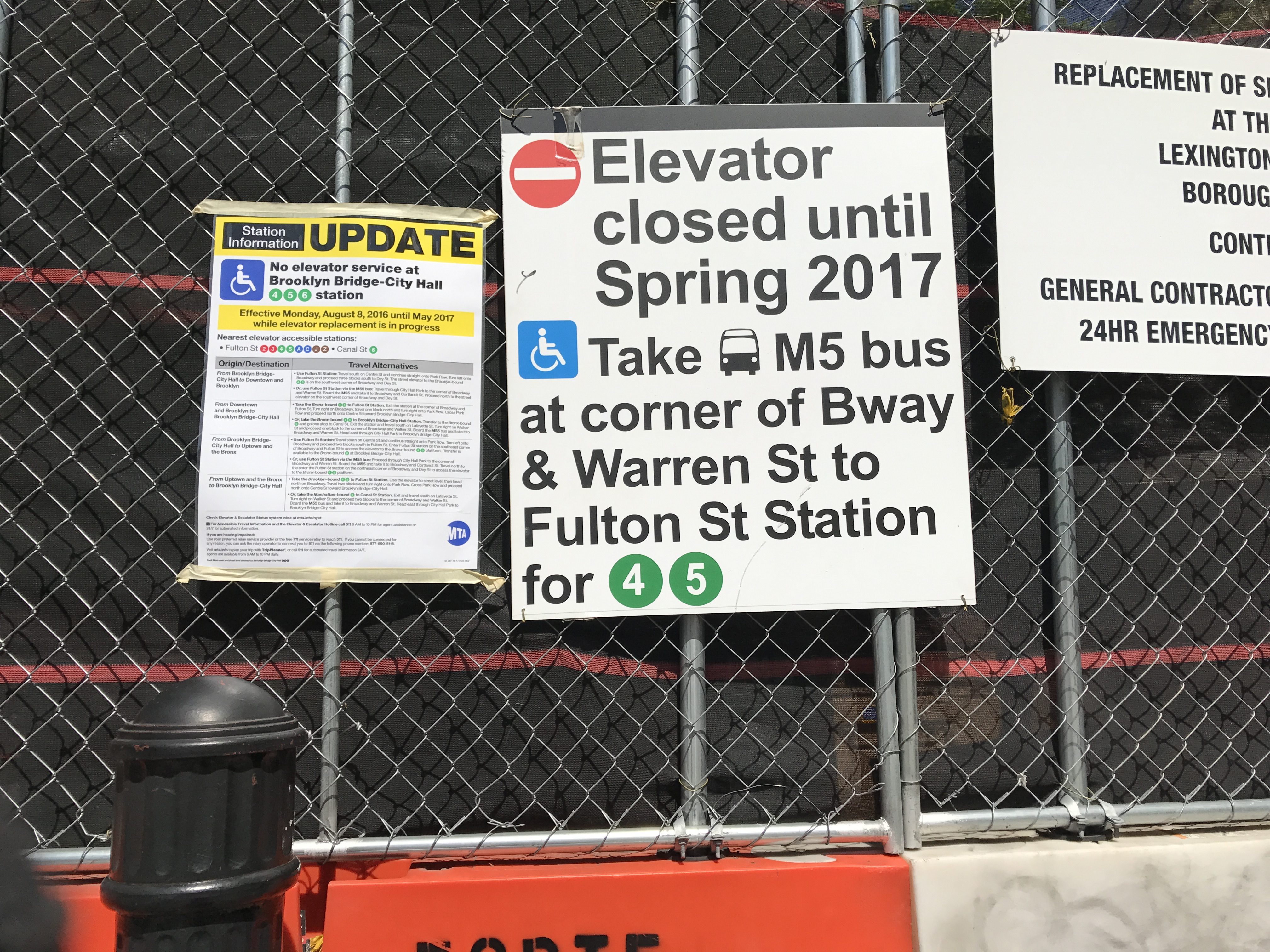

When riding the New York City subway, does it ever feel like every elevator or escalator you encounter is broken? This isn’t the stuff of hyperbole. NYC Comptroller Scott Stringer’s recent audit of New York MTA’s elevator and escalator maintenance practices wasn’t pretty, spotlighting serial neglect and dysfunction in the MTA’s Division of Elevators and Escalators (E&E).
While elevator and escalator maintenance failure affects every subway rider at one point or another, it has a profound impact on people with disabilities, parents pushing strollers, and the growing number of older New Yorkers who require step-free subway access. Stringer’s audit came on the heels of a lawsuit filed last month by people with disabilities alleging that the MTA has failed time and time again to make the subways reliably accessible.
Stringer’s investigation uncovered the following failures:
- The MTA didn’t perform 80% of preventive maintenance work on schedule
- A third of scheduled inspections and repairs were either not performed at all, or were performed way off schedule
- Of preventive maintenance work that was performed, only 25% of required checklists were completed by MTA workers
- MTA maintenance crews created work orders for only 25% of new defects discovered during preventive maintenance
- The MTA has no formal system for tracking repair of defects when work orders are created
The findings are alarming, raising questions about if, when, and how elevators and escalators are inspected and repaired, and whether anyone is managing the process. They also shed light on why the MTA’s subway elevators and escalators break so often.
Sadly, Stringer’s audit is the only the most recent in a growing canon of investigations into the MTA’s elevator problems. This collection of reports, going back to 2000, indicates that the MTA has made few efforts to improve elevators and escalators, or to take accessibility seriously.
- In 2000, Mark Green, NYC Public Advocate detailed the MTA’s elevator and escalator performance failures between 1994 and 2000, finding that the average subway station elevator was out of service an average of 26 days a year, and that 74% of downtime was due to broken equipment.
- In 2004, NY State Comptroller Alan Hevesi audited MTA accessibility for people with disabilities. It found the agency “does little to monitor the way the subway system is being used by people with disabilities…. Making the stations ADA compliant does not necessarily mean that the needs of individuals with disabilities are being met.”
- A 2008 NY Times investigation revealed that: “One of every six elevators and escalators in the subway system was out of service for more than a month last year,” and “Two-thirds of the subway elevators — many of which travel all of 15 feet — had at least one breakdown last year in which passengers were trapped inside.” The Times attributed this high outage rate to the MTA’s low training standards for maintenance workers. The Times found that workers “often rush[ed] balky elevators and escalators back into service without identifying the underlying causes of mechanical problems, leading to more breakdowns.”
As a whole, this 17-year history of investigation tells us that the MTA’s approach to subway accessibility is broken. As the Hevesi audit intimates, the agency is less concerned with the rider experience than it is with checking the ADA compliance box, treating accessibility as a legal, financial and operational burden worthy only of bare minimum effort.

This problem has persisted for so long because of a lack of leadership on the issue and no accountability for performance within the MTA. Whereas Boston’s MBTA and Chicago’s CTA have both set up internal accessibility offices precisely to increase accountability and accelerate progress, New York remains wedded to meeting the letter rather than the spirit of its ADA settlement.
Nearly 27 years after passage of the ADA, it shouldn’t take court action and external audits to make an accessible subway system a reality in New York City. Governor Cuomo and MTA leadership should prioritize subway accessibility in both capital planning and daily operations simply because it’s the right thing to do.
 Built to Win: Riders Alliance Campaign Secures Funding for More Frequent Subway Service
Built to Win: Riders Alliance Campaign Secures Funding for More Frequent Subway Service
Thanks to Riders' Alliance successful #6MinuteService campaign, New York City subway riders will enjoy more frequent service on nights and weekends, starting this summer. In this post, we chronicle the group's winning strategies and tactics.
Read More A Bus Agenda for New York City Mayor Eric Adams
A Bus Agenda for New York City Mayor Eric Adams
To create the “state-of-the-art bus transit system” of his campaign platform, Mayor Adams will have to both expand the quantity and improve the quality of bus lanes. We recommend these strategies to get it done.
Read More